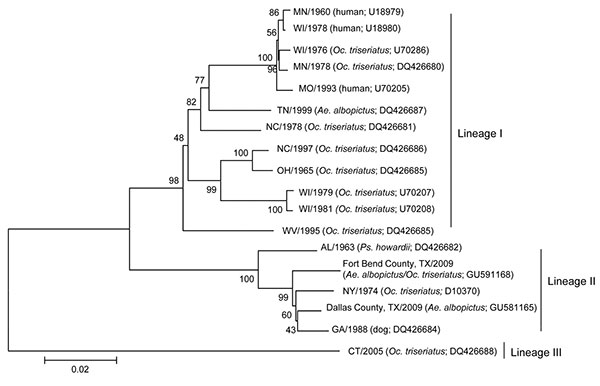Volume 16, Number 5—May 2010
Dispatch
La Crosse Virus in Aedes albopictus Mosquitoes, Texas, USA, 2009
Figure 2

Figure 2. Phylogeny of La Crosse virus (LACV) medium (M) segment sequences of diverse origins. According to a limited availability of full-length sequences in GenBank, 1,663 nt of the M segment glycoprotein gene open-reading frame are compared. Isolate source and GenBank accession nos. appear after the isolate designation for each taxon. Sequences were aligned by ClustalW (10) and neighbor-joining and maximum-parsimony trees were generated by using 2,000 bootstrap replicates with MEGA version 4 software (10). Highly similar topologies and confidence values were derived by all methods and a neighbor-joining tree is shown. Scale bar represents the number of nucleotide substitutions per site. The 2009 Texas (TX) isolates group with strong support with lineage 2 viruses of the extreme south and New York (NY), which suggests a likely southern origin for LACV isolates. MN, Minnesota; WI, Wisconsin; Oc., Ochlerotatus; MO, Missouri; TN, Tennessee; Ae., Aedes; NC, North Carolina; OH, Ohio; WV, West Virginia; AL, Alabama; Ps., psorophora; GA, Georgia; CT, Connecticut.
References
- Haddow AD, Odoi A. The incidence risk, clustering, and clinical presentation of La Crosse virus infections in the eastern United States, 2003–2007. PLoS ONE. 2009;4:e6145 .DOIPubMedGoogle Scholar
- Centers for Disease Control and Prevention. Aedes albopictus introduction—Texas. MMWR Morb Mortal Wkly Rep. 1986;35:141–2.PubMedGoogle Scholar
- Moore CG, Mitchell CJ. Aedes albopictus in the United States: ten-year presence and public health implications. Emerg Infect Dis. 1997;3:329–34. DOIPubMedGoogle Scholar
- Grimstad PR, Kobayashi JF, Zhang MB, Craig GB Jr. Recently introduced Aedes albopictus in the United States: potential vector of La Crosse virus (Bunyaviridae: California serogroup). J Am Mosq Control Assoc. 1989;5:422–7.PubMedGoogle Scholar
- Weaver SC, Reisen WK. Present and future arboviral threats. Antiviral Res. 2010;85:328–45. Epub 2009 Oct 24. DOIPubMedGoogle Scholar
- Gerhardt RR, Gottfried KL, Apperson CS, Davis BS, Erwin PC, Smith AB, First isolation of La Crosse virus from naturally infected Aedes albopictus. Emerg Infect Dis. 2001;7:807–11. DOIPubMedGoogle Scholar
- Klimas RA, Thompson WH, Calisher CH, Clark GC, Grimstad PR, Bishop DH. Genotypic varieties of La Crosse virus isolated from different geographic regions of the continental United States and evidence for a naturally occurring intertypic recombination of La Crosse virus. Am J Epidemiol. 1981;114:112–31.PubMedGoogle Scholar
- Lambert AJ, Lanciotti RS. Consensus amplification and novel multiplex sequencing method for S segment species identification of 47 viruses of the Orthobunyavirus, Phlebovirus, and Nairovirus genera of the family Bunyaviridae. J Clin Microbiol. 2009;47:2398–404. DOIPubMedGoogle Scholar
- Lambert AJ, Lanciotti RS. Molecular characterization of medically important viruses of the genus Orthobunyavirus. J Gen Virol. 2008;89:2580–5. DOIPubMedGoogle Scholar
- Tamura K, Dudley J, Nei M, Kumar S. MEGA4: Molecular Evolutionary Genetics Analysis (MEGA) software version 4.0. Mol Biol Evol. 2007; 1596–9. Epub 2007 May 7. DOIPubMedGoogle Scholar
- Armstrong PM, Andreadis TG. A new genetic variant of La Crosse virus (Bunyaviridae) isolated from New England. Am J Trop Med Hyg. 2006;75:491–6.PubMedGoogle Scholar
- Tesh RB, Shroyer DA. The mechanism of arbovirus transovarial transmission in mosquitoes: San Angelo virus in Aedes albopictus. Am J Trop Med Hyg. 1980;29:1394–404.PubMedGoogle Scholar
- Cheng LL, Rodas JD, Schultz KT, Christensen BM, Yuill TM, Israel BA. Potential for evolution of California serogroup bunyaviruses by genome reassortment in Aedes albopictus. Am J Trop Med Hyg. 1999;60:430–8.PubMedGoogle Scholar